Unit 1 How can we become good learners 知识点讲解课件(共58张PPT)
文档属性
| 名称 | Unit 1 How can we become good learners 知识点讲解课件(共58张PPT) |  | |
| 格式 | pptx | ||
| 文件大小 | 476.0KB | ||
| 资源类型 | 教案 | ||
| 版本资源 | 人教新目标(Go for it)版 | ||
| 科目 | 英语 | ||
| 更新时间 | 2024-07-03 22:26:30 | ||
图片预览

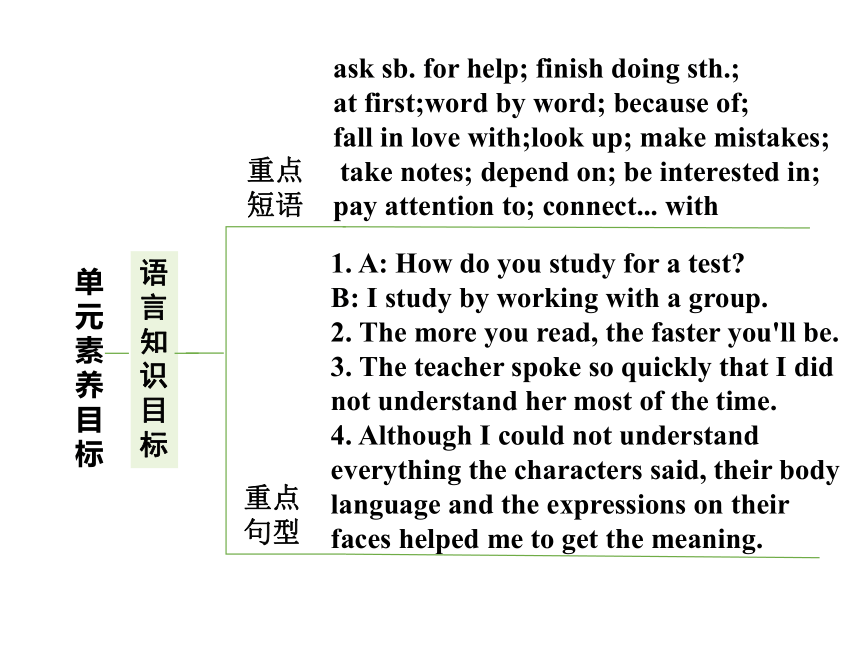
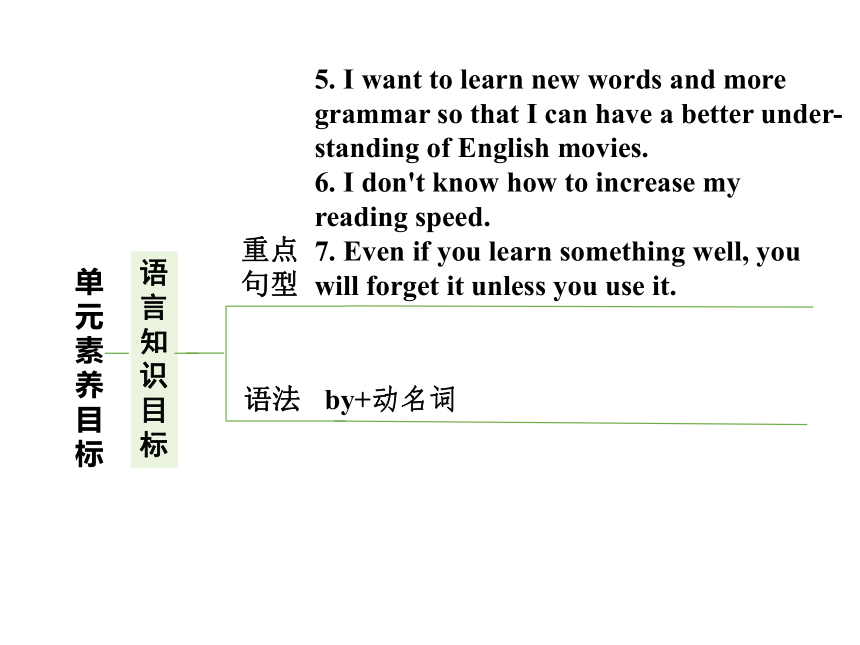


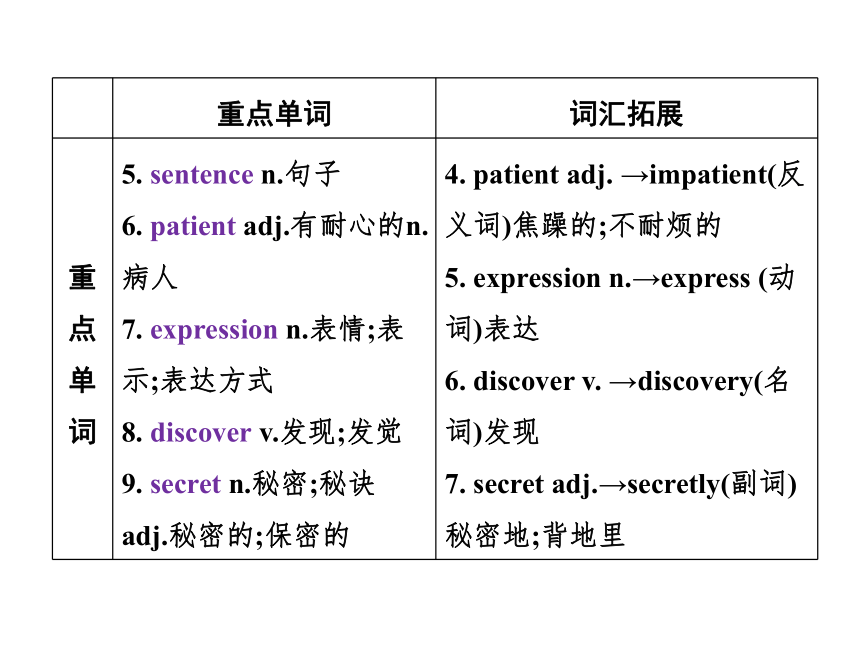
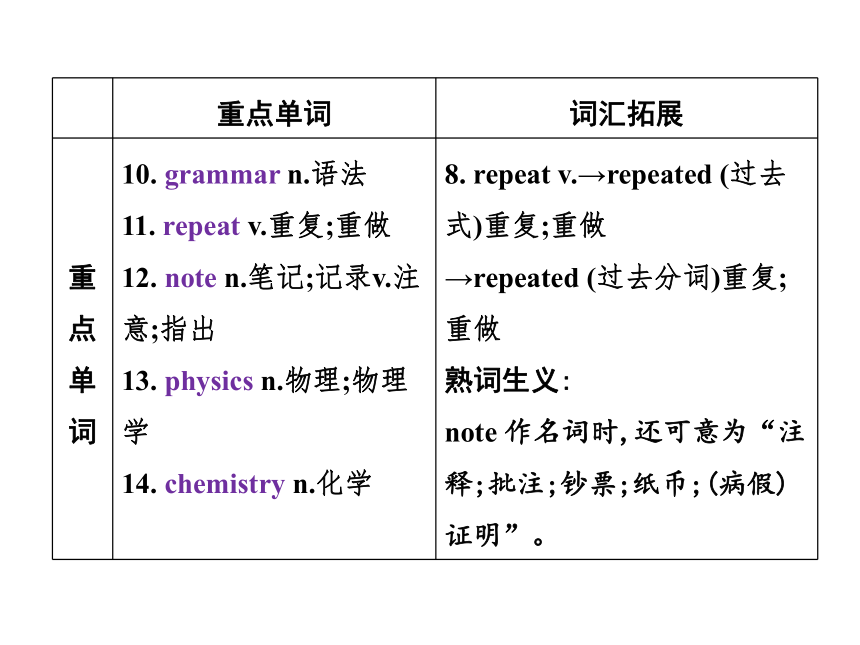
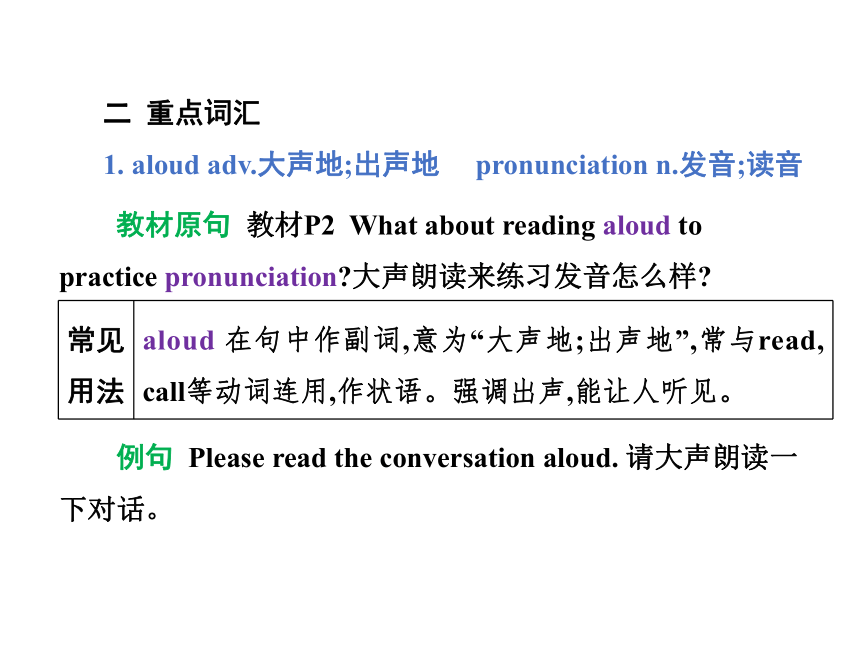
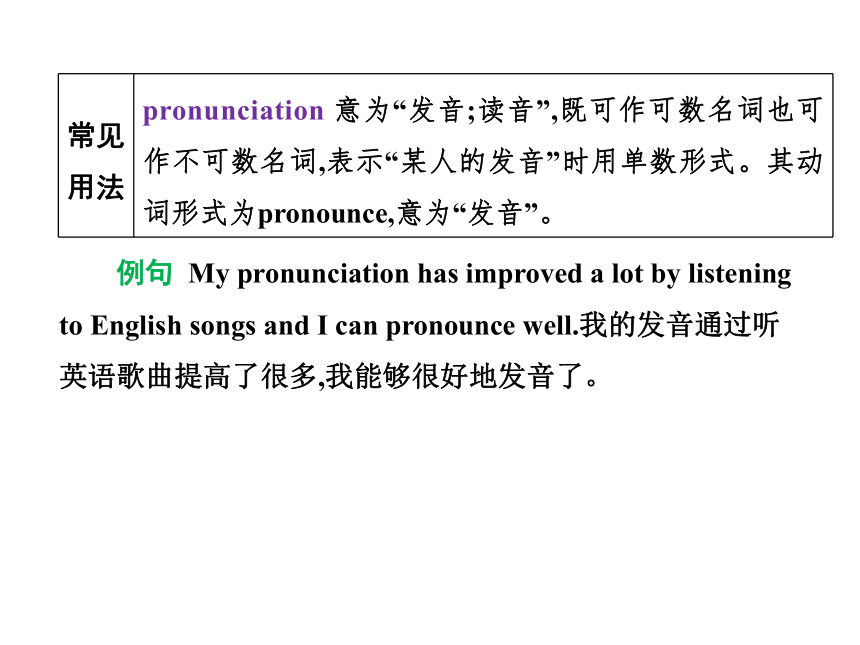
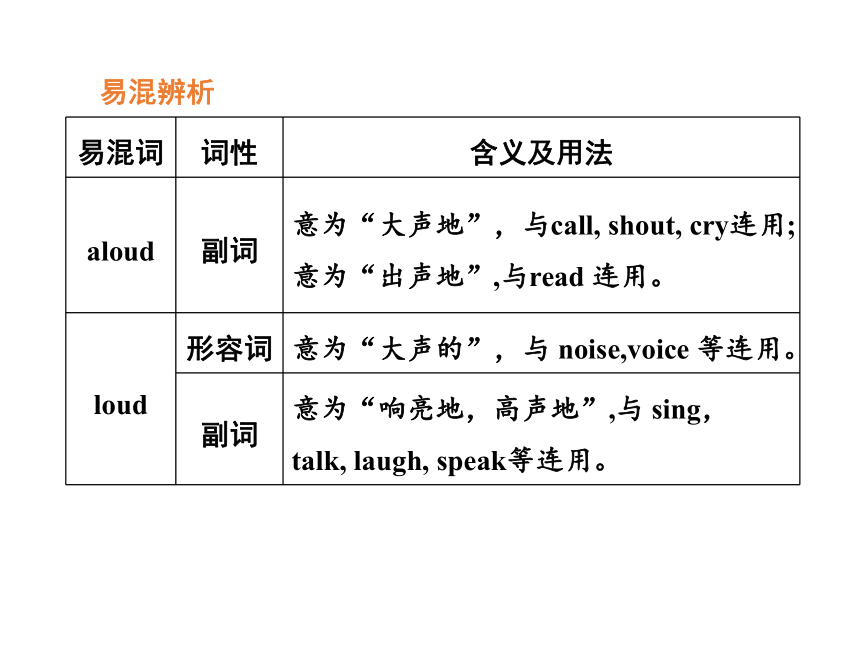
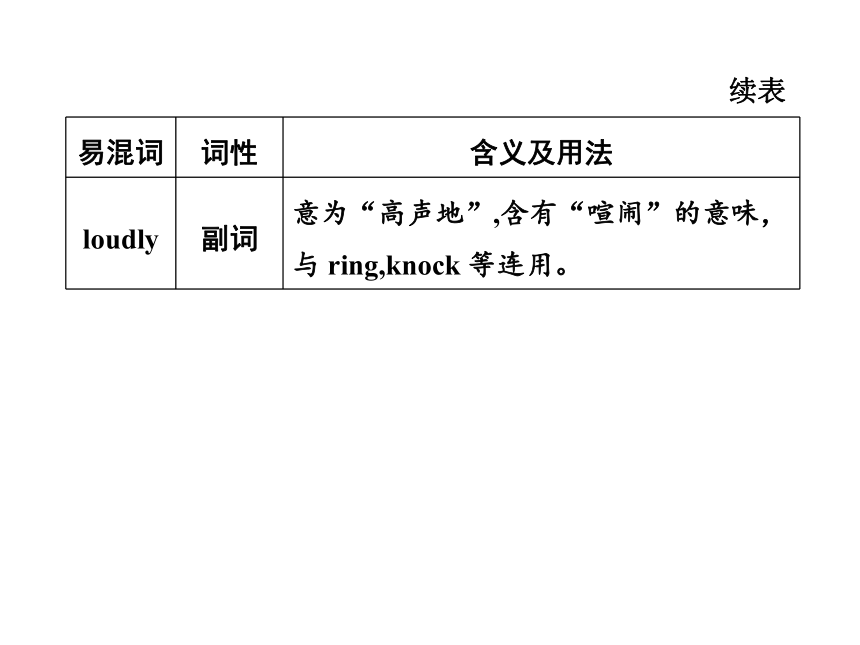

文档简介
(共58张PPT)
Unit 1 How can we become good learners
语
言
知识目
标
单元素养目标
词汇
话题
学会学习(Learning how to learn )
四会词
textbook; conversation; aloud; pronunciation; sentence; patient; expression; discover; secret; grammar; repeat; note; physics; chemistry; pro-nounce; increase; speed; review; partner; born; ability; create; brain;
active; attention; connect; knowledge; wisely
非四会词
pal; memorize; pattern;
overnight; lifelong
Unit 1 How can we become good learners
语
言
知识目
标
单元素养目标
重点
短语
ask sb. for help; finish doing sth.;
at first;word by word; because of;
fall in love with;look up; make mistakes;
take notes; depend on; be interested in;
pay attention to; connect... with
1. A: How do you study for a test
B: I study by working with a group.
2. The more you read, the faster you'll be.
3. The teacher spoke so quickly that I did not understand her most of the time.
4. Although I could not understand everything the characters said, their body language and the expressions on their faces helped me to get the meaning.
重点
句型
Unit 1 How can we become good learners
语
言
知识目
标
单元素养目标
5. I want to learn new words and more
grammar so that I can have a better under-
standing of English movies.
6. I don't know how to increase my
reading speed.
7. Even if you learn something well, you
will forget it unless you use it.
重点
句型
语法
by+动名词
Unit 1 How can we become good learners
语言能力目标
单元素养目标
听:能够听懂以学习方法为话题的听力材料
说:能够描述和询问自己或他人的学习方法
读:能够读懂以学习方法为话题的文章
写:能够书写以学习方法为话题的作文
Section A
一 单词背记及拓展
重点单词 词汇拓展
重 点 单 词 1. textbook n.教科书;课本 2. conversation n.交谈;谈话 3. aloud adv.大声地;出声地 4. pronunciation n.发音;读音 1. conversation n.→converse(动词)交谈;谈话
2. aloud adv.→loudly(近义词)大声地;响亮地
3. pronunciation n. →pronounce (动词)发音
Section A
重点单词 词汇拓展
重 点 单 词 5. sentence n.句子 6. patient adj.有耐心的n.病人 7. expression n.表情;表示;表达方式 8. discover v.发现;发觉 9. secret n.秘密;秘诀 adj.秘密的;保密的 4. patient adj. →impatient(反义词)焦躁的;不耐烦的
5. expression n.→express (动词)表达
6. discover v. →discovery(名词)发现
7. secret adj.→secretly(副词)秘密地;背地里
Section A
重点单词 词汇拓展
重 点 单 词 10. grammar n.语法 11. repeat v.重复;重做 12. note n.笔记;记录v.注意;指出 13. physics n.物理;物理学 14. chemistry n.化学 8. repeat v.→repeated (过去式)重复;重做
→repeated (过去分词)重复;重做
熟词生义:
note 作名词时,还可意为“注释;批注;钞票;纸币;(病假)证明”。
Section A
二 重点词汇
1. aloud adv.大声地;出声地 pronunciation n.发音;读音
教材原句 教材P2 What about reading aloud to practice pronunciation 大声朗读来练习发音怎么样
例句 Please read the conversation aloud. 请大声朗读一下对话。
常见用法 aloud 在句中作副词,意为“大声地;出声地”,常与read, call等动词连用,作状语。强调出声,能让人听见。
Section A
例句 My pronunciation has improved a lot by listening to English songs and I can pronounce well.我的发音通过听英语歌曲提高了很多,我能够很好地发音了。
常见用法 pronunciation 意为“发音;读音”,既可作可数名词也可作不可数名词,表示“某人的发音”时用单数形式。其动词形式为pronounce,意为“发音”。
Section A
易混辨析
易混词 词性 含义及用法
aloud 副词 意为“大声地”,与call, shout, cry连用;意为“出声地”,与read 连用。
loud 形容词 意为“大声的”,与 noise,voice 等连用。
副词 意为“响亮地,高声地”,与 sing,
talk, laugh, speak等连用。
Section A
易混词 词性 含义及用法
loudly 副词 意为“高声地”,含有“喧闹”的意味,
与 ring,knock 等连用。
续表
Section A
2. patient adj.有耐心的 n.病人
教材原句 教材P2 Well, be patient.哦,耐心一点儿。
例句 You'll just have to be patient and wait till I'm off the phone.你只能耐心点儿,等我打完电话。
常见用法 patient 作形容词,意为“有耐心的”,可作表语或定语。be patient with sb.意为“对某人有耐心”。patient还可作可数名词,意为“病人”。
Section A
图解妙记
patient adj.
有耐心的
patient n.
病人
Section A
3. look up (在词典、参考书中或通过电脑)查阅;抬头看
教材原句 教材P3 But because I wanted to understand the story, I looked them up in a dictionary.但因为我想了解这个故事,所以我在词典中查阅了它们。
常见用法 look up 意为“(在词典、参考书中或通过电脑)查阅”,后可直接跟宾语,但当look up的宾语是代词时,宾语要放在look与 up之间。look up 还有“抬头看”的意思。
Section A
看图背例句
Li Ming looks up the new word in the dictionary.
李明在词典里查生词。
Section A
拓展提升
含有look 的其他常见短语:
look at 看
look after 照顾
look around 环顾
look back 向后看;回顾
look down on/ upon 轻视
look for 寻找
look through 浏览;翻阅
Section A
三 重点句式
1.the+比较级...,the+比较级...
教材原句 教材P2 The more you read, the faster you'll be.你读得越多,你(读书的速度)就会越快。
常见用法 “the+比较级..., the+比较级..”意为“越……就越……”,表示一方的程度随着另一方的变化而变化。
例句 Many people believe that the more a person exercises, the healthier he will be.很多人相信,一个人锻炼得越多,就会越健康。
Section A
拓展提升
get/ become+形容词比较级+and+形容词比较级”表示“变得越来越……”,and连接同一个形容词的比较级。当表示“越来越……”,形容词为多音节词或部分双音节词时,用“moreand more+原级”形式。
Section A
2. so... that...的用法
教材原句 教材P3 The teacher spoke so quickly that I did not understand her most of the time.老师说得太快了,以至于大部分时间我听不懂她(的话)。
常见用法 本句是含结果状语从句的主从复合句。so... that...意为“如此……以至于……”,so修饰形容词或副词
句式结构 so... that...引导结果状语从句,意为“如此……以至于……”。
Section A
例句 I am so tired that I can't walk any farther.我如此累以至于不能再走了。
Readers is so good that many people like to watch it.《朗读者》是如此得好,以至于很多人都喜欢看。
Section A
易混辨析
词组 含义及用法
so...that... 意为“如此……以至于……”,so +形容词/副词原级 + that从句。
so that 意为“以便,为了”,引导目的状语从句,从句中常使用can/ could/ may/
might/ will/ would/ should等情态动词或助动词。意为“因此,所以”,引导结果状语从句,在so that前可以用逗号。
Section A
3.表示建议的句型
教材原句 教材P2 What about listening to tapes 听录音带怎么样
常见用法 “What about... ”意为“……怎么样 ”,相当于“How about... ”。about是介词,后跟名词、代词或动名词。常用来征求对方的意见或向对方提出建议,也可用来询问情况。
Section A
例句 ——What about going to see the movie called The Battle at Lake Changjin II tonight 今天晚上去看名叫《长津湖之水门桥》的电影怎么样
——That's a great idea!好主意!
Section A
拓展提升
表示建议的短语/句型:
Why don't you do sth. / Whynot do sth.
Would you mind doing sth. had better do sth.
Would you like to do sth.
Would/ Could you please dosth.
Section A
4. although 引导的让步状语从句
教材原句 教材P3 Although I could not understand everything the characters said, their body language and the expressions on their faces helped me to get the meaning.尽管我不能完全理解(电影中)人物所说的话,但是他们的肢体语言和脸上的表情帮助我理解(他们的)意思。
Section A
常见用法 although 意为“虽然;尽管;即使”,引导的让步状语从句放在主句前后均可,有时还可放在句中。although不能与but连用,但可以与yet, still 连用。
例句 Although the times keep changing, young people in China have shown the same promise.尽管时代在不断变化,但中国的年轻人展现出了同样的希望。
Section A
易混辨析
although 与 though
相同点:although 与 though 都可以作连词,表示“虽 然,尽管”,引导让步状语从句,只是although 比 though 更正式。
不同点:(1)although 不可以作副词。(2)though 可以作副词,且一般放在句末,不放在句首,意为“可是,不过”。固定短语:as though 好像,仿佛;even though即使,纵然。
Section A
5. find+it+adj.+to do sth.
教材原句 教材P3 Why did Wei Fen find it difficult to learn English 为什么魏芬发现学英语很难
句式结构 find+it+adj.+to do sth.发现做某事……
常见用法 find 后接复合宾语,句中的it是形式宾语,真正的宾语为to do sth.。动词不定式作宾语,后面又有一个形容词作宾语补足语时,习惯上用形式宾语it代替,而把动词不定式移到句子的后面去。
Section A
例句 ——Mr. Brown, I find it hard to learn physics well.布朗老师,我发现学好物理很难。
——Come on! Practice makes perfect.加油!熟能生巧。
Section A
拓展提升
“find +it +adj.+to do sth.”可以转换为“find(that) it+be+adj.+to do sth.”这一结构。后者为含有宾语从句的复合句,其中it在宾语从句中作形式主语,真正的主语是后面的动词不定式,形容词在宾语从句中作表语。如:I find it boring to listen to the speech.=I find (that) it is boring to listen to the speech.我发现听那个演讲很无聊。
● 考点清单解读
一 单词背记及拓展
二 重点词汇
三 重点句式
四 重点语法
Section B
Section B
一 单词背记及拓展
重点单词 词汇拓展
重 点 单 词 1. pronounce v.发音 2. increase v.增加;增长 3. speed n.速度 4. review v. & n.回顾;复习 1. pronounce v. →pronunciation(名词)发音;读音
2. increase v. →increasing(现在分词)增加;增长
→increased(过去式)增加;增长
→increased (过去分词)增加;增长
Section B
重点单词 词汇拓展
重 点 单 词 5. partner n.搭档;同伴 6. born v.出生adj.天生的 7. ability n.能力;才能 8. create v.创造;创建 9. brain n.大脑 3. ability n.→able(形容词)有能力的;能干的
4. create v.→creative(形容词)有创造性的
→creation (名词)创造
Section B
重点单词 词汇拓展
重 点 单 词 10. active adj.活跃的;积极的 11. attention n.注意;关注 12. connect v.(使)连接;与……有联系 13. knowledge n.知识;学问 14. wisely adv.明智地;聪明地 5. connect v.→connecting(现在分词)(使)连接;与……有联系
→connected (过去式/过去分词)(使)连接;与……有联系
→connection(名词)连接;关系 6. knowledge n. →knowledgeable(形容词)知识渊博的;有见识的
Section B
二 重点词汇
1. born v.出生 adj.天生的
教材原句 教材P6 Everyone is born with the ability to learn.每个人生来具有学习的能力。
例句 Bill was born with two blind eyes.比尔天生双目失明。
常见用法 born 作动词时,意为“出生”;作形容词时,意为“天生的”。be born with sth.生来就有某种疾病/性格等。
Section B
拓展提升
born 还可 用于“be born+adj.”结构,表示“生来……”。如:The girl was born deaf.那个女孩生来就失聪。
Section B
2. depend on 取决于……;由……而定
教材原句 教材P6 But whether or not you can do this well depends on your learning habits.但是你能否做好取决于你的学习习惯。
例句 How do animals depend on each other 动物们如何依赖彼此
常见用法 depend on 是固定搭配,不仅有“取决于……;由……而定”的意思,还有“依赖;依靠”的意思。
Section B
拓展提升
口语中 It(all)depends./ That depends.意为“那要看情况。”如:——It’s said that shopping online is safe.据说在线购物很安全。——That depends. You'd betterbe careful.那要视情况而定。你最好当心一点。
Section B
3. pay attention to注意;关注
教材原句 教材P6 Studies show that if you are interested in something, your brain is more active and it is also easier for you to pay attention to it for a long time.研究表明,如果你对某件事情感兴趣,你的大脑便会更加活跃,同时你也更容易长时间地关注它。
常见用法 pay attention to意为“注意;关注”。其中attention是名词,意为“注意;关注”。
Section B
例句 We should pay attention to saving energy.我们应该注意节约能源。
易错提升
pay attention to 短语中 to 为介词,后接名词、动词-ing形式或者名词性从句。
拓展提升
attention 的其他固定搭配:
catch/ get/ attract one's attention 吸引某人的注意力
keep one's attention 保持某人的注意力
Section B
4. connect... with... 把……和……连接或联系起来
教材原句 教材P6 Good learners often connect what they need to learn with something interesting.优秀的学习者经常把他们需要学习的东西和某些有趣的事情联系起来。
常见用法 connect 为及物动词,意为“(使)连接;与……有联系”。connect...with...把……和……连接或联系起来
例句 A railway connects Beijing with Shanghai.一条铁路连接北京和上海。
Section B
拓展提升
connection 为名词,意为“连接;关系”。如:There's a connection between pollution and the death of trees. 污染和树木的死亡之间有关系。
Section B
三 重点句式
1. whether or not...
教材原句 教材P6 But whether or not you can do this well depends on your learning habits.但是你能否做好取决于你的学习习惯。
常见用法 whether or not 意为“是否”,常出现在宾语从句、主语从句或状语从句中,whether和or not可以分开,or not放在从句句尾。
例句 Whether we help him or not, he will win.无论我们是否帮助他,他都会赢。
Section B
易混辨析
whether 与if都可以引导宾语从句,表示“是否”,在口语或间接引语中两者可以互换使用。但在有些情况下,whether 与 if的用法有一定的区别:①whether 引导的从句常可以与连词or或 or not直接连用,而if一般不能。②当宾语从句提到句首时,只能用whether引导,而不能用 if。
Section B
2. It is+adj.+for sb.+to do sth.
教材原句 教材P6 Studies show that if you are interested in something, your brain is more active and it is also easier for you to pay attention to it for a long time.研究表明,如果你对某件事情感兴趣,你的大脑便会更加活跃,同时你也更容易长时间地关注它。
句式结构 It is+adj.+for sb.+to do sth.
Section B
常见用法 “It is+adj.+for sb.+to do sth.”意为“对某人来说做某事是……的”。在该句型中,it作形式主语,动词不定式是真正的主语,for引出逻辑主语。
例句 It’s important for the students to learn English well.对学生们来说学好英语很重要。
Section B
易混辨析
“It’s+adj.+for sb.+to do sth.”与“It’'s+adj. +of sb.+to do sth."的用法区别:
(1)介词为for时,常用表示事物特点、特征或表示客观形势的形容词,如easy,hard,difficult,important 等。
(2)介词为of 时,常用表示人物性格、品质或表示主观感情、态度的形容词,如good, nice, clever,kind等。
Section B
3.unless 引导的条件状语从句
教材原句 教材P6 Even if you learn something well, you will forget it unless you use it.即使你某样东西学得很好,不用它的话你也会忘记。
常见用法 unless 是连词,意为“如果不;除非”,引导条件状语从句,同if..not,两者可以进行同义转换。
例句 You will fail the test unless you study hard. =You will fail the test if you don't study hard.如果你不努力学习,你考试会不及格的。
Section B
易错提示
if 或unless引导条件状语从句,如果主句是一般将来时,从句要用一般现在时,可巧记为“主将从现”。如:You won't be able to use the computer unless you know its password.你将不能使用这台电脑,除非你知道它的密码。
Section B
四 重点语法
“介词 by+v.-ing 形式”表示方式、方法
教材原句 教材P1 I study by working with a group.我通过小组合作学习。
教材原句 教材P4 You can read faster by reading word groups.通过读词组你可以读得更快。
Section B
常见用法 by意为“通过……;靠……;凭……”时,其后加名词、代词或动词-ing形式,在句中作方式状语,可以用来回答how引导的特殊疑问句。by还有以下用法:
(1)“by+地点名词”表示方位,意为“在……旁边;靠近”。
(2)“by+时间名词”意为“到……时为止;不迟于……;在……之前”,此时主句可用完成时态。
(3)“by+表示交通工具、交通方式的名词(名词前不加冠词,不变复数)”意为“坐……;乘……;骑……”。
Section B
例句 You can practice playing football by joining a football club.你可以通过加入足球俱乐部来练习踢足球
拓展提升
含有 by 的常用短语:
by means of 通过……的方式
by the way 顺便说一下
one by one 一个接一个
step by step 一步接一步
side by side 肩并肩
by oneself 独自 by accident 偶然
Section B
易混辨析
by, with 与 in 用法区别
by 使用某种方式、方法或交通工具,还可表示“在……旁边”。后接名词、代词或动名词。
with 使用某种工具或身体的某个部位。后接名词或代词。
in 使用某种语言、语调或颜色。后接名词或代词。
语篇考法精讲
跨学科试题解题技巧
典例剖析
It also feels more natural for Chinese speakers than for English speakers to use the make-a-ten method. When adding two numbers,Chinese students often break down the numbers into parts and regroup them into tens and ones. For example,9+5 becomes 9+1+4. This method greatly helps students work out math problems. Many teachers in America are teaching their students the make-a-ten method.
语篇考法精讲
However, they are still having trouble because of the unclear and difficult English number words.
[中考新考法·跨数学]
If you use the make-a-ten method, what will 8+7become
A.6+2+7
B.7+1+7
C.8+1+6
D.8+2+5
语篇考法精讲
例句 You can practice playing football by joining a football club.你可以通过加入足球俱乐部来练习踢足球
[解析]通读文章内容可知,9+5变成了9+1+4,是使用了数学的凑十法,因此8+7应该变成8+2+5。故选D。
[答案] D
语篇考法精讲
考法说明
跨学科综合题不是单纯地考查英语知识,而是要求同学们在理解英语文章及题目的同时,综合运用多学科基础知识和背景知识来解题,因而具有考查综合知识的特点。解答这类试题时,需要学生掌握好各学科基础知识,以此来拓宽知识面,能够看懂英语表达的多学科知识内容。
语篇考法精讲
技巧点拨
解答此类试题时,需要学生分析文本、理解文本细节信息,分析题干,找出关键词,再充分利用所学的各科知识,进行分析、推理、判断,从而得出正确答案。
Unit 1 How can we become good learners
语
言
知识目
标
单元素养目标
词汇
话题
学会学习(Learning how to learn )
四会词
textbook; conversation; aloud; pronunciation; sentence; patient; expression; discover; secret; grammar; repeat; note; physics; chemistry; pro-nounce; increase; speed; review; partner; born; ability; create; brain;
active; attention; connect; knowledge; wisely
非四会词
pal; memorize; pattern;
overnight; lifelong
Unit 1 How can we become good learners
语
言
知识目
标
单元素养目标
重点
短语
ask sb. for help; finish doing sth.;
at first;word by word; because of;
fall in love with;look up; make mistakes;
take notes; depend on; be interested in;
pay attention to; connect... with
1. A: How do you study for a test
B: I study by working with a group.
2. The more you read, the faster you'll be.
3. The teacher spoke so quickly that I did not understand her most of the time.
4. Although I could not understand everything the characters said, their body language and the expressions on their faces helped me to get the meaning.
重点
句型
Unit 1 How can we become good learners
语
言
知识目
标
单元素养目标
5. I want to learn new words and more
grammar so that I can have a better under-
standing of English movies.
6. I don't know how to increase my
reading speed.
7. Even if you learn something well, you
will forget it unless you use it.
重点
句型
语法
by+动名词
Unit 1 How can we become good learners
语言能力目标
单元素养目标
听:能够听懂以学习方法为话题的听力材料
说:能够描述和询问自己或他人的学习方法
读:能够读懂以学习方法为话题的文章
写:能够书写以学习方法为话题的作文
Section A
一 单词背记及拓展
重点单词 词汇拓展
重 点 单 词 1. textbook n.教科书;课本 2. conversation n.交谈;谈话 3. aloud adv.大声地;出声地 4. pronunciation n.发音;读音 1. conversation n.→converse(动词)交谈;谈话
2. aloud adv.→loudly(近义词)大声地;响亮地
3. pronunciation n. →pronounce (动词)发音
Section A
重点单词 词汇拓展
重 点 单 词 5. sentence n.句子 6. patient adj.有耐心的n.病人 7. expression n.表情;表示;表达方式 8. discover v.发现;发觉 9. secret n.秘密;秘诀 adj.秘密的;保密的 4. patient adj. →impatient(反义词)焦躁的;不耐烦的
5. expression n.→express (动词)表达
6. discover v. →discovery(名词)发现
7. secret adj.→secretly(副词)秘密地;背地里
Section A
重点单词 词汇拓展
重 点 单 词 10. grammar n.语法 11. repeat v.重复;重做 12. note n.笔记;记录v.注意;指出 13. physics n.物理;物理学 14. chemistry n.化学 8. repeat v.→repeated (过去式)重复;重做
→repeated (过去分词)重复;重做
熟词生义:
note 作名词时,还可意为“注释;批注;钞票;纸币;(病假)证明”。
Section A
二 重点词汇
1. aloud adv.大声地;出声地 pronunciation n.发音;读音
教材原句 教材P2 What about reading aloud to practice pronunciation 大声朗读来练习发音怎么样
例句 Please read the conversation aloud. 请大声朗读一下对话。
常见用法 aloud 在句中作副词,意为“大声地;出声地”,常与read, call等动词连用,作状语。强调出声,能让人听见。
Section A
例句 My pronunciation has improved a lot by listening to English songs and I can pronounce well.我的发音通过听英语歌曲提高了很多,我能够很好地发音了。
常见用法 pronunciation 意为“发音;读音”,既可作可数名词也可作不可数名词,表示“某人的发音”时用单数形式。其动词形式为pronounce,意为“发音”。
Section A
易混辨析
易混词 词性 含义及用法
aloud 副词 意为“大声地”,与call, shout, cry连用;意为“出声地”,与read 连用。
loud 形容词 意为“大声的”,与 noise,voice 等连用。
副词 意为“响亮地,高声地”,与 sing,
talk, laugh, speak等连用。
Section A
易混词 词性 含义及用法
loudly 副词 意为“高声地”,含有“喧闹”的意味,
与 ring,knock 等连用。
续表
Section A
2. patient adj.有耐心的 n.病人
教材原句 教材P2 Well, be patient.哦,耐心一点儿。
例句 You'll just have to be patient and wait till I'm off the phone.你只能耐心点儿,等我打完电话。
常见用法 patient 作形容词,意为“有耐心的”,可作表语或定语。be patient with sb.意为“对某人有耐心”。patient还可作可数名词,意为“病人”。
Section A
图解妙记
patient adj.
有耐心的
patient n.
病人
Section A
3. look up (在词典、参考书中或通过电脑)查阅;抬头看
教材原句 教材P3 But because I wanted to understand the story, I looked them up in a dictionary.但因为我想了解这个故事,所以我在词典中查阅了它们。
常见用法 look up 意为“(在词典、参考书中或通过电脑)查阅”,后可直接跟宾语,但当look up的宾语是代词时,宾语要放在look与 up之间。look up 还有“抬头看”的意思。
Section A
看图背例句
Li Ming looks up the new word in the dictionary.
李明在词典里查生词。
Section A
拓展提升
含有look 的其他常见短语:
look at 看
look after 照顾
look around 环顾
look back 向后看;回顾
look down on/ upon 轻视
look for 寻找
look through 浏览;翻阅
Section A
三 重点句式
1.the+比较级...,the+比较级...
教材原句 教材P2 The more you read, the faster you'll be.你读得越多,你(读书的速度)就会越快。
常见用法 “the+比较级..., the+比较级..”意为“越……就越……”,表示一方的程度随着另一方的变化而变化。
例句 Many people believe that the more a person exercises, the healthier he will be.很多人相信,一个人锻炼得越多,就会越健康。
Section A
拓展提升
get/ become+形容词比较级+and+形容词比较级”表示“变得越来越……”,and连接同一个形容词的比较级。当表示“越来越……”,形容词为多音节词或部分双音节词时,用“moreand more+原级”形式。
Section A
2. so... that...的用法
教材原句 教材P3 The teacher spoke so quickly that I did not understand her most of the time.老师说得太快了,以至于大部分时间我听不懂她(的话)。
常见用法 本句是含结果状语从句的主从复合句。so... that...意为“如此……以至于……”,so修饰形容词或副词
句式结构 so... that...引导结果状语从句,意为“如此……以至于……”。
Section A
例句 I am so tired that I can't walk any farther.我如此累以至于不能再走了。
Readers is so good that many people like to watch it.《朗读者》是如此得好,以至于很多人都喜欢看。
Section A
易混辨析
词组 含义及用法
so...that... 意为“如此……以至于……”,so +形容词/副词原级 + that从句。
so that 意为“以便,为了”,引导目的状语从句,从句中常使用can/ could/ may/
might/ will/ would/ should等情态动词或助动词。意为“因此,所以”,引导结果状语从句,在so that前可以用逗号。
Section A
3.表示建议的句型
教材原句 教材P2 What about listening to tapes 听录音带怎么样
常见用法 “What about... ”意为“……怎么样 ”,相当于“How about... ”。about是介词,后跟名词、代词或动名词。常用来征求对方的意见或向对方提出建议,也可用来询问情况。
Section A
例句 ——What about going to see the movie called The Battle at Lake Changjin II tonight 今天晚上去看名叫《长津湖之水门桥》的电影怎么样
——That's a great idea!好主意!
Section A
拓展提升
表示建议的短语/句型:
Why don't you do sth. / Whynot do sth.
Would you mind doing sth. had better do sth.
Would you like to do sth.
Would/ Could you please dosth.
Section A
4. although 引导的让步状语从句
教材原句 教材P3 Although I could not understand everything the characters said, their body language and the expressions on their faces helped me to get the meaning.尽管我不能完全理解(电影中)人物所说的话,但是他们的肢体语言和脸上的表情帮助我理解(他们的)意思。
Section A
常见用法 although 意为“虽然;尽管;即使”,引导的让步状语从句放在主句前后均可,有时还可放在句中。although不能与but连用,但可以与yet, still 连用。
例句 Although the times keep changing, young people in China have shown the same promise.尽管时代在不断变化,但中国的年轻人展现出了同样的希望。
Section A
易混辨析
although 与 though
相同点:although 与 though 都可以作连词,表示“虽 然,尽管”,引导让步状语从句,只是although 比 though 更正式。
不同点:(1)although 不可以作副词。(2)though 可以作副词,且一般放在句末,不放在句首,意为“可是,不过”。固定短语:as though 好像,仿佛;even though即使,纵然。
Section A
5. find+it+adj.+to do sth.
教材原句 教材P3 Why did Wei Fen find it difficult to learn English 为什么魏芬发现学英语很难
句式结构 find+it+adj.+to do sth.发现做某事……
常见用法 find 后接复合宾语,句中的it是形式宾语,真正的宾语为to do sth.。动词不定式作宾语,后面又有一个形容词作宾语补足语时,习惯上用形式宾语it代替,而把动词不定式移到句子的后面去。
Section A
例句 ——Mr. Brown, I find it hard to learn physics well.布朗老师,我发现学好物理很难。
——Come on! Practice makes perfect.加油!熟能生巧。
Section A
拓展提升
“find +it +adj.+to do sth.”可以转换为“find(that) it+be+adj.+to do sth.”这一结构。后者为含有宾语从句的复合句,其中it在宾语从句中作形式主语,真正的主语是后面的动词不定式,形容词在宾语从句中作表语。如:I find it boring to listen to the speech.=I find (that) it is boring to listen to the speech.我发现听那个演讲很无聊。
● 考点清单解读
一 单词背记及拓展
二 重点词汇
三 重点句式
四 重点语法
Section B
Section B
一 单词背记及拓展
重点单词 词汇拓展
重 点 单 词 1. pronounce v.发音 2. increase v.增加;增长 3. speed n.速度 4. review v. & n.回顾;复习 1. pronounce v. →pronunciation(名词)发音;读音
2. increase v. →increasing(现在分词)增加;增长
→increased(过去式)增加;增长
→increased (过去分词)增加;增长
Section B
重点单词 词汇拓展
重 点 单 词 5. partner n.搭档;同伴 6. born v.出生adj.天生的 7. ability n.能力;才能 8. create v.创造;创建 9. brain n.大脑 3. ability n.→able(形容词)有能力的;能干的
4. create v.→creative(形容词)有创造性的
→creation (名词)创造
Section B
重点单词 词汇拓展
重 点 单 词 10. active adj.活跃的;积极的 11. attention n.注意;关注 12. connect v.(使)连接;与……有联系 13. knowledge n.知识;学问 14. wisely adv.明智地;聪明地 5. connect v.→connecting(现在分词)(使)连接;与……有联系
→connected (过去式/过去分词)(使)连接;与……有联系
→connection(名词)连接;关系 6. knowledge n. →knowledgeable(形容词)知识渊博的;有见识的
Section B
二 重点词汇
1. born v.出生 adj.天生的
教材原句 教材P6 Everyone is born with the ability to learn.每个人生来具有学习的能力。
例句 Bill was born with two blind eyes.比尔天生双目失明。
常见用法 born 作动词时,意为“出生”;作形容词时,意为“天生的”。be born with sth.生来就有某种疾病/性格等。
Section B
拓展提升
born 还可 用于“be born+adj.”结构,表示“生来……”。如:The girl was born deaf.那个女孩生来就失聪。
Section B
2. depend on 取决于……;由……而定
教材原句 教材P6 But whether or not you can do this well depends on your learning habits.但是你能否做好取决于你的学习习惯。
例句 How do animals depend on each other 动物们如何依赖彼此
常见用法 depend on 是固定搭配,不仅有“取决于……;由……而定”的意思,还有“依赖;依靠”的意思。
Section B
拓展提升
口语中 It(all)depends./ That depends.意为“那要看情况。”如:——It’s said that shopping online is safe.据说在线购物很安全。——That depends. You'd betterbe careful.那要视情况而定。你最好当心一点。
Section B
3. pay attention to注意;关注
教材原句 教材P6 Studies show that if you are interested in something, your brain is more active and it is also easier for you to pay attention to it for a long time.研究表明,如果你对某件事情感兴趣,你的大脑便会更加活跃,同时你也更容易长时间地关注它。
常见用法 pay attention to意为“注意;关注”。其中attention是名词,意为“注意;关注”。
Section B
例句 We should pay attention to saving energy.我们应该注意节约能源。
易错提升
pay attention to 短语中 to 为介词,后接名词、动词-ing形式或者名词性从句。
拓展提升
attention 的其他固定搭配:
catch/ get/ attract one's attention 吸引某人的注意力
keep one's attention 保持某人的注意力
Section B
4. connect... with... 把……和……连接或联系起来
教材原句 教材P6 Good learners often connect what they need to learn with something interesting.优秀的学习者经常把他们需要学习的东西和某些有趣的事情联系起来。
常见用法 connect 为及物动词,意为“(使)连接;与……有联系”。connect...with...把……和……连接或联系起来
例句 A railway connects Beijing with Shanghai.一条铁路连接北京和上海。
Section B
拓展提升
connection 为名词,意为“连接;关系”。如:There's a connection between pollution and the death of trees. 污染和树木的死亡之间有关系。
Section B
三 重点句式
1. whether or not...
教材原句 教材P6 But whether or not you can do this well depends on your learning habits.但是你能否做好取决于你的学习习惯。
常见用法 whether or not 意为“是否”,常出现在宾语从句、主语从句或状语从句中,whether和or not可以分开,or not放在从句句尾。
例句 Whether we help him or not, he will win.无论我们是否帮助他,他都会赢。
Section B
易混辨析
whether 与if都可以引导宾语从句,表示“是否”,在口语或间接引语中两者可以互换使用。但在有些情况下,whether 与 if的用法有一定的区别:①whether 引导的从句常可以与连词or或 or not直接连用,而if一般不能。②当宾语从句提到句首时,只能用whether引导,而不能用 if。
Section B
2. It is+adj.+for sb.+to do sth.
教材原句 教材P6 Studies show that if you are interested in something, your brain is more active and it is also easier for you to pay attention to it for a long time.研究表明,如果你对某件事情感兴趣,你的大脑便会更加活跃,同时你也更容易长时间地关注它。
句式结构 It is+adj.+for sb.+to do sth.
Section B
常见用法 “It is+adj.+for sb.+to do sth.”意为“对某人来说做某事是……的”。在该句型中,it作形式主语,动词不定式是真正的主语,for引出逻辑主语。
例句 It’s important for the students to learn English well.对学生们来说学好英语很重要。
Section B
易混辨析
“It’s+adj.+for sb.+to do sth.”与“It’'s+adj. +of sb.+to do sth."的用法区别:
(1)介词为for时,常用表示事物特点、特征或表示客观形势的形容词,如easy,hard,difficult,important 等。
(2)介词为of 时,常用表示人物性格、品质或表示主观感情、态度的形容词,如good, nice, clever,kind等。
Section B
3.unless 引导的条件状语从句
教材原句 教材P6 Even if you learn something well, you will forget it unless you use it.即使你某样东西学得很好,不用它的话你也会忘记。
常见用法 unless 是连词,意为“如果不;除非”,引导条件状语从句,同if..not,两者可以进行同义转换。
例句 You will fail the test unless you study hard. =You will fail the test if you don't study hard.如果你不努力学习,你考试会不及格的。
Section B
易错提示
if 或unless引导条件状语从句,如果主句是一般将来时,从句要用一般现在时,可巧记为“主将从现”。如:You won't be able to use the computer unless you know its password.你将不能使用这台电脑,除非你知道它的密码。
Section B
四 重点语法
“介词 by+v.-ing 形式”表示方式、方法
教材原句 教材P1 I study by working with a group.我通过小组合作学习。
教材原句 教材P4 You can read faster by reading word groups.通过读词组你可以读得更快。
Section B
常见用法 by意为“通过……;靠……;凭……”时,其后加名词、代词或动词-ing形式,在句中作方式状语,可以用来回答how引导的特殊疑问句。by还有以下用法:
(1)“by+地点名词”表示方位,意为“在……旁边;靠近”。
(2)“by+时间名词”意为“到……时为止;不迟于……;在……之前”,此时主句可用完成时态。
(3)“by+表示交通工具、交通方式的名词(名词前不加冠词,不变复数)”意为“坐……;乘……;骑……”。
Section B
例句 You can practice playing football by joining a football club.你可以通过加入足球俱乐部来练习踢足球
拓展提升
含有 by 的常用短语:
by means of 通过……的方式
by the way 顺便说一下
one by one 一个接一个
step by step 一步接一步
side by side 肩并肩
by oneself 独自 by accident 偶然
Section B
易混辨析
by, with 与 in 用法区别
by 使用某种方式、方法或交通工具,还可表示“在……旁边”。后接名词、代词或动名词。
with 使用某种工具或身体的某个部位。后接名词或代词。
in 使用某种语言、语调或颜色。后接名词或代词。
语篇考法精讲
跨学科试题解题技巧
典例剖析
It also feels more natural for Chinese speakers than for English speakers to use the make-a-ten method. When adding two numbers,Chinese students often break down the numbers into parts and regroup them into tens and ones. For example,9+5 becomes 9+1+4. This method greatly helps students work out math problems. Many teachers in America are teaching their students the make-a-ten method.
语篇考法精讲
However, they are still having trouble because of the unclear and difficult English number words.
[中考新考法·跨数学]
If you use the make-a-ten method, what will 8+7become
A.6+2+7
B.7+1+7
C.8+1+6
D.8+2+5
语篇考法精讲
例句 You can practice playing football by joining a football club.你可以通过加入足球俱乐部来练习踢足球
[解析]通读文章内容可知,9+5变成了9+1+4,是使用了数学的凑十法,因此8+7应该变成8+2+5。故选D。
[答案] D
语篇考法精讲
考法说明
跨学科综合题不是单纯地考查英语知识,而是要求同学们在理解英语文章及题目的同时,综合运用多学科基础知识和背景知识来解题,因而具有考查综合知识的特点。解答这类试题时,需要学生掌握好各学科基础知识,以此来拓宽知识面,能够看懂英语表达的多学科知识内容。
语篇考法精讲
技巧点拨
解答此类试题时,需要学生分析文本、理解文本细节信息,分析题干,找出关键词,再充分利用所学的各科知识,进行分析、推理、判断,从而得出正确答案。
同课章节目录
- Unit 1 How can we become good learners.
- Section A
- Section B
- Unit 2 I think that mooncakes are delicious!
- Section A
- Section B
- Unit 3 Could you please tell me where the restroom
- Section A
- Section B
- Unit 4 I used to be afraid of the dark.
- Section A
- Section B
- Unit 5 What are the shirts made of?
- Section A
- Section B
- Review of Units 1-5
- Unit 6 When was it invented?
- Section A
- Section B
- Unit 7 Teenagers should be allowed to choose their
- Section A
- Section B
- Unit 8 It must belong to Carla.
- Section A
- Section B
- Unit 9 I like music that I can dance to.
- Section A
- Section B
- Unit 10 You're supposed to shake hands.
- Section A
- Section B
- Review of Units 6-10
- Unit 11 Sad movies make me cry.
- Section A
- Section B
- Unit 12 Life is full of the unexpected
- Section A
- Section B
- Unit 13 We're trying to save the earth!
- Section A
- Section B
- Unit 14 I remember meeting all of you in Grade 7.
- Section A
- Section B
- Review of Units 11-14
